Cogenetic Origin of Magmatic Enclaves in Peralkaline Felsic Volcanic Rocks from the Sanshui Basin, South China
Abstract
:1. Introduction
2. Geological Background
3. Materials and Methods
4. Results
4.1. Petrography
4.2. Whole-Rock Geochemistry
| Sample | 19ss036-1 | 19ss037-2a | 19ss037-2b | 20ss020-1 | 20ss022-1 | 19ss036-1 | 20ss020-1 | 20ss022-1 | Kilombe, Kenya | Azores, Portugal |
|---|---|---|---|---|---|---|---|---|---|---|
| Rock Type | Syenite | Syenite | Syenite | Syenite | Syenite | Trachyte | Comendite | Trachyte | Syenite, n = 20 | Syenite, n = 17 |
| Group | Enclave | Enclave | Enclave | Enclave | Enclave | Host | Host | Host | Enclave | Enclave |
| Ba | 98.00 | 65.20 | 75.60 | 88.10 | 72.30 | 40.90 | 61.10 | 19.70 | 48.70 | 61.00 |
| Be | 4.51 | 4.19 | 3.97 | 4.11 | 4.62 | 6.22 | 7.69 | 7.91 | 4.11 | |
| Co | 0.60 | 1.00 | 1.00 | 0.80 | 0.90 | 21.40 | 0.30 | 0.60 | 4.16 | |
| Cr | 1 | 1 | 1 | 1 | 1 | 1.3 | 3 | 2 | ||
| Cs | 0.58 | 2.60 | 2.35 | 0.52 | 1.67 | 0.81 | 2.98 | 2.56 | 0.91 | 1.44 |
| Ga | 40.70 | 41.90 | 40.60 | 39.10 | 39.80 | 46.90 | 50.70 | 45.30 | 35.55 | 29.57 |
| Hf | 21.20 | 23.10 | 20.80 | 20.10 | 20.40 | 42.50 | 52.10 | 25.00 | 14.40 | 25.36 |
| Nb | 188 | 177 | 166 | 179 | 176 | 272 | 336 | 164 | 195 | 217 |
| Ni | 0.5 | 0.3 | 0.3 | 0.5 | 0.4 | 0.8 | 1.2 | 1.8 | ||
| Pb | 10.00 | 9.20 | 12.40 | 9.30 | 10.80 | 19.50 | 13.60 | 10.40 | ||
| Rb | 166 | 219 | 193 | 160 | 188 | 229 | 306 | 176 | 137 | 186 |
| Sr | 22.80 | 16.20 | 16.00 | 19.80 | 21.10 | 9.03 | 14.50 | 7.20 | 11.85 | 79.15 |
| Ta | 9.50 | 11.60 | 9.50 | 9.10 | 9.90 | 17.40 | 20.90 | 9.40 | 11.57 | 13.67 |
| Th | 19.35 | 22.30 | 21.40 | 18.20 | 23.30 | 36.90 | 49.50 | 19.45 | 18.31 | 25.64 |
| U | 3.25 | 2.74 | 2.33 | 3.01 | 2.45 | 5.16 | 5.20 | 3.54 | 5.03 | 7.97 |
| V | 17 | 5 | 6 | 14 | 8 | 1.33 | 2.0 | 1.0 | 35.75 | |
| Zr | 972 | 997 | 883 | 903 | 913 | 1834 | 2360 | 1190 | 558 | 1119 |
| Y | 96 | 94 | 85 | 92 | 90 | 165 | 205 | 171 | 44 | 56 |
| La | 245 | 183 | 155 | 215 | 204 | 227 | 439 | 416 | 145 | 157 |
| Ce | 313 | 130 | 398 | 301 | 170 | 267 | 167 | 723 | 175 | 292 |
| Pr | 54 | 37 | 33 | 50 | 39 | 47 | 82 | 91 | 24 | 30 |
| Nd | 191 | 128 | 116 | 173 | 128 | 167 | 297 | 315 | 81 | 103 |
| Sm | 32.50 | 20.80 | 19.10 | 29.30 | 20.10 | 32.30 | 57.30 | 59.00 | 11.91 | 16.04 |
| Eu | 1.79 | 1.05 | 1.17 | 1.66 | 1.29 | 1.18 | 3.10 | 5.46 | 1.34 | 1.62 |
| Gd | 24.70 | 18.00 | 16.10 | 22.90 | 15.97 | 27.70 | 49.30 | 45.40 | 10.04 | 13.27 |
| Tb | 3.62 | 3.00 | 2.69 | 3.35 | 2.63 | 5.46 | 7.23 | 6.97 | 1.42 | 2.04 |
| Dy | 20.10 | 18.20 | 15.95 | 18.80 | 15.87 | 29.20 | 38.30 | 35.30 | 8.19 | 11.21 |
| Ho | 3.53 | 3.47 | 3.10 | 3.28 | 3.03 | 5.71 | 7.01 | 6.39 | 1.59 | 2.11 |
| Er | 9.66 | 10.05 | 8.98 | 8.91 | 8.77 | 16.50 | 19.00 | 16.80 | 4.82 | 6.21 |
| Tm | 1.35 | 1.48 | 1.34 | 1.28 | 1.37 | 2.92 | 2.72 | 2.38 | 0.89 | 0.94 |
| Yb | 8.88 | 9.99 | 9.02 | 8.21 | 8.94 | 17.80 | 17.60 | 14.65 | 6.15 | 6.27 |
| Lu | 1.28 | 1.47 | 1.31 | 1.18 | 1.30 | 2.42 | 2.52 | 2.20 | 1.02 | 0.93 |
| LaN/YbN | 19.79 | 13.10 | 12.33 | 18.78 | 16.37 | 9.15 | 17.89 | 20.37 | 16.89 | 17.99 |
| Ce/Ce* | 0.64 | 0.37 | 1.30 | 0.69 | 0.44 | 0.60 | 0.20 | 0.87 | 0.66 | 0.97 |
| Eu/Eu* | 0.19 | 0.16 | 0.20 | 0.19 | 0.21 | 0.12 | 0.17 | 0.31 | 0.36 | 0.33 |
| Nb/U | 58 | 64 | 71 | 59 | 72 | 53 | 65 | 46 |
4.3. Mineral Geochemistry
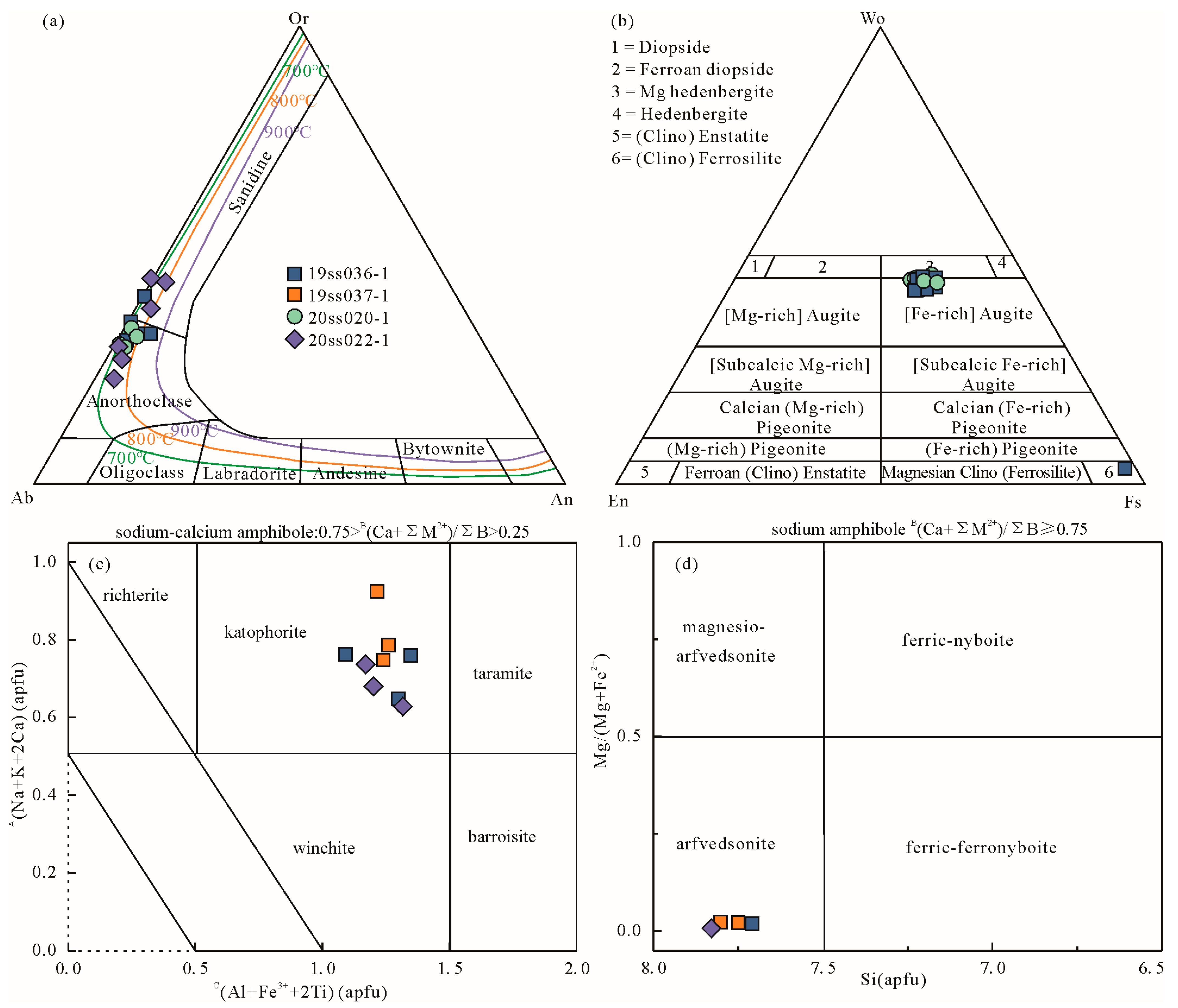
| Point | 036-2-1 | 036-2-2 | 036-2-3 | 036-2-4 | 036-2-5 | 022-2-1 | 022-2-2 | 022-2-3 | 022-2-4 | 020-2-1 | 020-2-2 | 020-2-3 | 020-2-4 | 020-2-5 | 020-2-6 |
|---|---|---|---|---|---|---|---|---|---|---|---|---|---|---|---|
| SiO2 | 66.77 | 67.49 | 66.95 | 65.87 | 66.60 | 67.76 | 67.27 | 68.40 | 65.36 | 66.83 | 66.46 | 66.83 | 67.81 | 67.69 | 66.95 |
| TiO2 | 0.05 | 0.02 | 0.02 | 0.05 | 0.03 | 0.06 | 0.04 | 0.02 | 0.07 | 0.04 | 0.11 | 0.00 | 0.05 | 0.13 | 0.06 |
| Al2O3 | 18.47 | 18.57 | 18.82 | 18.87 | 19.32 | 18.49 | 18.74 | 17.70 | 18.84 | 19.60 | 18.70 | 17.84 | 18.16 | 18.49 | 17.84 |
| FeOt | 0.18 | 0.42 | 0.26 | 0.20 | 0.23 | 0.37 | 0.15 | 0.27 | 0.42 | 0.32 | 0.14 | 0.92 | 0.26 | 0.23 | 0.26 |
| MnO | 0.01 | 0.01 | 0.03 | 0.00 | 0.00 | - | 0.03 | 0.00 | 0.00 | 0.00 | 0.02 | 0.00 | 0.02 | 0.00 | 0.01 |
| CaO | 1.19 | 0.18 | 0.12 | 0.76 | 0.44 | 0.34 | 0.70 | 0.25 | 0.56 | 0.86 | 0.68 | 0.00 | 0.27 | 0.71 | 0.66 |
| Na2O | 6.89 | 6.85 | 6.93 | 7.59 | 7.96 | 7.46 | 6.93 | 8.18 | 8.45 | 8.90 | 6.96 | 6.44 | 8.32 | 8.26 | 6.32 |
| K2O | 5.49 | 5.67 | 7.27 | 5.82 | 5.60 | 5.89 | 5.16 | 5.45 | 5.55 | 4.13 | 6.80 | 7.84 | 5.42 | 4.81 | 7.88 |
| Total | 99.04 | 99.21 | 100.41 | 99.16 | 100.17 | 100.39 | 99.01 | 100.27 | 99.25 | 100.68 | 99.87 | 99.86 | 100.31 | 100.31 | 99.97 |
| Formulae on basis of 8 oxygens | |||||||||||||||
| Si | 3.003 | 3.022 | 2.993 | 2.973 | 2.971 | 3.012 | 3.013 | 3.039 | 2.957 | 2.956 | 2.985 | 3.017 | 3.016 | 3.004 | 3.015 |
| Ti | 0.002 | 0.001 | 0.001 | 0.002 | 0.001 | 0.002 | 0.001 | 0.001 | 0.002 | 0.001 | 0.004 | 0.000 | 0.002 | 0.004 | 0.002 |
| Al | 0.979 | 0.984 | 0.992 | 1.004 | 1.016 | 0.969 | 0.989 | 0.927 | 1.004 | 1.022 | 0.990 | 0.949 | 0.952 | 0.967 | 0.947 |
| Fe3+ | 0.007 | 0.016 | 0.010 | 0.008 | 0.009 | 0.014 | 0.006 | 0.010 | 0.016 | 0.012 | 0.005 | 0.035 | 0.010 | 0.009 | 0.010 |
| Mn | 0.001 | 0.000 | 0.001 | 0.000 | 0.000 | 0.000 | 0.001 | 0.000 | 0.000 | 0.000 | 0.001 | 0.000 | 0.001 | 0.000 | 0.000 |
| Ca | 0.057 | 0.008 | 0.006 | 0.037 | 0.021 | 0.016 | 0.034 | 0.012 | 0.027 | 0.041 | 0.033 | 0.000 | 0.013 | 0.034 | 0.032 |
| Na | 0.600 | 0.598 | 0.600 | 0.665 | 0.688 | 0.643 | 0.602 | 0.705 | 0.741 | 0.764 | 0.606 | 0.563 | 0.718 | 0.711 | 0.552 |
| K | 0.315 | 0.325 | 0.414 | 0.335 | 0.319 | 0.334 | 0.295 | 0.309 | 0.320 | 0.233 | 0.389 | 0.451 | 0.307 | 0.272 | 0.453 |
| total | 4.964 | 4.955 | 5.017 | 5.022 | 5.024 | 4.990 | 4.940 | 5.003 | 5.068 | 5.028 | 5.014 | 5.015 | 5.018 | 5.000 | 5.011 |
| An | 6 | 1 | 1 | 4 | 2 | 2 | 4 | 1 | 3 | 4 | 3 | 0 | 1 | 3 | 3 |
| Ab | 62 | 64 | 59 | 64 | 67 | 65 | 65 | 69 | 68 | 74 | 59 | 56 | 69 | 70 | 53 |
| Or | 32 | 35 | 41 | 32 | 31 | 34 | 32 | 30 | 29 | 22 | 38 | 44 | 30 | 27 | 44 |
| T | 872 | 877 | 866 | 877 | 883 | 891 | 890 | 899 | 898 | 871 | 841 | 834 | 862 | 864 | 828 |
| Piont | 022-1 | 022-2 | 022-3 | 022-4 | 022-5 | 022-6 | 036-1 | 036-2 | 036-3 | 036-4 | 036-5 | 036-6 | 036-1 |
|---|---|---|---|---|---|---|---|---|---|---|---|---|---|
| SiO2 | 48.91 | 49.38 | 49.15 | 48.14 | 49.45 | 49.65 | 49.58 | 49.88 | 49.87 | 48.97 | 49.77 | 49.88 | 51.03 |
| TiO2 | 0.59 | 0.51 | 0.49 | 0.56 | 0.60 | 0.48 | 0.34 | 0.33 | 0.44 | 0.52 | 0.39 | 0.29 | 0.03 |
| Al2O3 | 0.39 | 0.33 | 0.32 | 0.32 | 0.51 | 0.42 | 0.31 | 0.35 | 0.32 | 0.32 | 0.39 | 0.36 | 0.16 |
| FeO | 20.97 | 21.49 | 21.89 | 22.55 | 19.78 | 22.15 | 20.67 | 21.15 | 21.35 | 22.57 | 22.19 | 20.87 | 33.64 |
| MnO | 0.84 | 0.91 | 0.98 | 0.89 | 0.82 | 0.92 | 0.87 | 0.94 | 0.92 | 0.90 | 0.98 | 0.83 | 2.04 |
| MgO | 6.97 | 6.41 | 6.84 | 5.77 | 7.12 | 5.46 | 7.05 | 6.42 | 6.33 | 5.63 | 5.61 | 6.76 | 0.01 |
| CaO | 21.00 | 20.01 | 19.98 | 20.95 | 20.47 | 19.83 | 20.15 | 20.38 | 19.78 | 20.30 | 19.53 | 20.45 | 1.01 |
| Na2O | 0.39 | 0.41 | 0.43 | 0.38 | 0.37 | 0.62 | 0.46 | 0.58 | 0.44 | 0.43 | 0.50 | 0.54 | 11.39 |
| Total | 100.05 | 99.45 | 100.08 | 99.56 | 99.14 | 99.52 | 99.44 | 100.03 | 99.44 | 99.64 | 99.36 | 99.97 | 99.31 |
| Formulae on basis of 6 oxygens | |||||||||||||
| Si | 1.945 | 1.972 | 1.956 | 1.942 | 1.967 | 1.985 | 1.973 | 1.977 | 1.986 | 1.965 | 1.991 | 1.976 | 2.121 |
| Ti | 0.018 | 0.015 | 0.015 | 0.017 | 0.018 | 0.014 | 0.010 | 0.010 | 0.013 | 0.016 | 0.012 | 0.009 | 0.001 |
| Al | 0.018 | 0.016 | 0.015 | 0.015 | 0.024 | 0.020 | 0.015 | 0.016 | 0.015 | 0.015 | 0.019 | 0.017 | 0.008 |
| Fe3+ | 0.129 | 0.063 | 0.115 | 0.143 | 0.052 | 0.043 | 0.081 | 0.079 | 0.030 | 0.083 | 0.022 | 0.084 | 0.922 |
| Fe2+ | 0.561 | 0.651 | 0.607 | 0.609 | 0.603 | 0.695 | 0.602 | 0.618 | 0.680 | 0.669 | 0.720 | 0.602 | 0.157 |
| Mn | 0.028 | 0.030 | 0.033 | 0.031 | 0.028 | 0.031 | 0.029 | 0.031 | 0.031 | 0.031 | 0.033 | 0.028 | 0.072 |
| Mg | 0.413 | 0.380 | 0.406 | 0.347 | 0.422 | 0.325 | 0.418 | 0.380 | 0.376 | 0.337 | 0.335 | 0.399 | 0.000 |
| Ca | 0.895 | 0.853 | 0.852 | 0.905 | 0.872 | 0.849 | 0.859 | 0.866 | 0.844 | 0.873 | 0.837 | 0.868 | 0.045 |
| Na | 0.030 | 0.032 | 0.033 | 0.030 | 0.029 | 0.048 | 0.036 | 0.044 | 0.034 | 0.033 | 0.038 | 0.042 | 0.917 |
| Total | 4.036 | 4.012 | 4.032 | 4.039 | 4.015 | 4.012 | 4.023 | 4.022 | 4.008 | 4.023 | 4.006 | 4.023 | 4.243 |
| Wo | 45 | 44 | 43 | 45 | 45 | 44 | 44 | 45 | 44 | 44 | 44 | 44 | 4 |
| En | 21 | 20 | 20 | 17 | 22 | 17 | 21 | 20 | 19 | 17 | 17 | 20 | 0 |
| Fs | 35 | 37 | 36 | 38 | 34 | 39 | 35 | 36 | 37 | 38 | 39 | 35 | 96 |
| T1 | - | - | - | - | - | 880 | - | - | 898 | - | 880 | - | - |
| P1 | 0.61 | 0.72 | 0.67 | 0.89 | 0.53 | 1.14 | 0.32 | 0.23 | 0.29 | 0.36 | 0.58 | 0.20 | - |
| T2 | 867 | 869 | 867 | 867 | 888 | 867 | 869 | 867 | 875 | 867 | 870 | 883 | - |
| P2 | 1.28 | 1.50 | 1.50 | 1.50 | 1.50 | 1.13 | 1.33 | 1.03 | 1.17 | 1.25 | 1.25 | 1.07 | - |
| T3 | 936 | 938 | 935 | 925 | 940 | 925 | 877 | 875 | 875 | 867 | 869 | 876 | - |
| P3 | 2 | 2 | 2 | 2 | 2 | 2 | 2 | 2 | 2 | 2 | 2 | 2 | - |
| Point | 022-1-1 | 022-1-2 | 022-1-3 | 022-1-4 | 036-1-1 | 036-1-2 | 036-1-3 | 036-1-4 | 037-1-1 | 037-1-2 | 037-1-3 | 037-1-4 | 037-1-5 |
|---|---|---|---|---|---|---|---|---|---|---|---|---|---|
| SiO2 | 49.75 | 50.38 | 48.93 | 49.63 | 49.96 | 49.25 | 48.27 | 49.72 | 48.67 | 48.88 | 49.50 | 50.14 | 49.08 |
| TiO2 | 0.30 | 0.94 | 1.01 | 0.67 | 0.78 | 1.13 | 0.60 | 0.70 | 0.47 | 0.65 | 0.74 | 0.64 | 0.76 |
| Al2O3 | 0.19 | 0.39 | 0.49 | 0.56 | 0.33 | 0.49 | 0.37 | 0.53 | 0.54 | 0.62 | 0.45 | 0.46 | 0.59 |
| FeOt | 34.50 | 35.56 | 33.98 | 34.15 | 34.13 | 33.57 | 35.83 | 34.24 | 35.21 | 35.99 | 34.69 | 34.45 | 34.11 |
| MnO | 1.29 | 1.06 | 1.20 | 1.17 | 1.37 | 1.17 | 1.07 | 0.90 | 1.08 | 0.88 | 0.92 | 1.16 | 1.19 |
| MgO | 0.13 | 0.11 | 0.21 | 0.25 | 0.27 | 0.29 | 0.19 | 0.27 | 0.31 | 0.27 | 0.29 | 0.30 | 0.28 |
| CaO | 1.72 | 2.95 | 2.73 | 2.69 | 2.19 | 2.32 | 2.35 | 2.67 | 2.66 | 2.65 | 1.89 | 2.08 | 2.68 |
| Na2O | 6.33 | 6.14 | 5.82 | 6.57 | 6.28 | 7.37 | 6.16 | 6.65 | 6.33 | 6.00 | 7.14 | 6.77 | 7.39 |
| K2O | 1.32 | 1.30 | 1.34 | 1.37 | 1.33 | 1.37 | 1.33 | 1.34 | 1.33 | 1.30 | 1.35 | 1.36 | 1.36 |
| F | 2.05 | 1.33 | 1.43 | 1.39 | 1.67 | 1.21 | 0.98 | 2.15 | 1.90 | 1.69 | 1.59 | 1.76 | 1.92 |
| Cl | 0.03 | 0.05 | 0.03 | 0.09 | 0.06 | 0.05 | 0.02 | 0.05 | 0.04 | 0.07 | 0.06 | 0.05 | 0.07 |
| Total | 96.73 | 99.66 | 96.57 | 97.94 | 97.64 | 97.71 | 96.76 | 98.30 | 97.73 | 98.26 | 97.93 | 98.42 | 98.60 |
| Formulae on basis of 23 oxygens | |||||||||||||
| Si | 7.826 | 7.791 | 7.723 | 7.751 | 7.806 | 7.707 | 7.642 | 7.770 | 7.664 | 7.677 | 7.747 | 7.800 | 7.673 |
| Al | 0.137 | 0.150 | 0.237 | 0.197 | 0.147 | 0.235 | 0.325 | 0.176 | 0.299 | 0.283 | 0.199 | 0.146 | 0.274 |
| Ti | 0.011 | 0.045 | 0.023 | 0.038 | 0.027 | 0.048 | 0.016 | 0.037 | 0.015 | 0.022 | 0.041 | 0.036 | 0.037 |
| T.sum | 7.974 | 7.986 | 7.983 | 7.986 | 7.980 | 7.991 | 7.983 | 7.983 | 7.978 | 7.981 | 7.987 | 7.982 | 7.984 |
| Al | 0.000 | 0.000 | 0.000 | 0.000 | 0.000 | 0.000 | 0.000 | 0.000 | 0.000 | 0.000 | 0.000 | 0.000 | 0.000 |
| Ti | 0.024 | 0.064 | 0.097 | 0.041 | 0.065 | 0.085 | 0.056 | 0.045 | 0.041 | 0.055 | 0.046 | 0.039 | 0.052 |
| Fe3+ | 1.204 | 1.071 | 1.121 | 1.087 | 1.167 | 1.083 | 1.233 | 0.999 | 1.175 | 1.128 | 1.079 | 1.114 | 1.109 |
| Mn2+ | 0.144 | 0.124 | 0.136 | 0.137 | 0.153 | 0.140 | 0.122 | 0.107 | 0.124 | 0.101 | 0.111 | 0.134 | 0.141 |
| Mg | 0.029 | 0.026 | 0.050 | 0.058 | 0.064 | 0.069 | 0.044 | 0.064 | 0.073 | 0.063 | 0.068 | 0.070 | 0.065 |
| Fe2+ | 3.340 | 3.540 | 3.360 | 3.434 | 3.321 | 3.397 | 3.422 | 3.529 | 3.438 | 3.514 | 3.474 | 3.408 | 3.448 |
| C.sum | 4.741 | 4.826 | 4.764 | 4.758 | 4.769 | 4.774 | 4.877 | 4.743 | 4.852 | 4.861 | 4.778 | 4.764 | 4.816 |
| Mn2+ | 0.028 | 0.015 | 0.025 | 0.018 | 0.027 | 0.015 | 0.021 | 0.012 | 0.021 | 0.016 | 0.012 | 0.019 | 0.016 |
| Fe2+ | 0.000 | 0.000 | 0.005 | 0.000 | 0.000 | 0.000 | 0.088 | 0.000 | 0.024 | 0.084 | 0.000 | 0.000 | 0.000 |
| Ca | 0.444 | 0.600 | 0.603 | 0.579 | 0.501 | 0.524 | 0.551 | 0.579 | 0.589 | 0.582 | 0.461 | 0.478 | 0.578 |
| Na | 1.568 | 1.426 | 1.433 | 1.533 | 1.532 | 1.644 | 1.409 | 1.527 | 1.427 | 1.352 | 1.599 | 1.578 | 1.597 |
| B.sum | 2.040 | 2.041 | 2.065 | 2.130 | 2.060 | 2.183 | 2.069 | 2.118 | 2.060 | 2.034 | 2.072 | 2.074 | 2.192 |
| Na | 0.364 | 0.414 | 0.348 | 0.455 | 0.371 | 0.592 | 0.482 | 0.488 | 0.505 | 0.474 | 0.566 | 0.462 | 0.642 |
| K | 0.275 | 0.263 | 0.278 | 0.279 | 0.275 | 0.278 | 0.276 | 0.273 | 0.275 | 0.268 | 0.275 | 0.277 | 0.278 |
| A.sum | 0.639 | 0.678 | 0.626 | 0.735 | 0.646 | 0.871 | 0.758 | 0.761 | 0.780 | 0.742 | 0.841 | 0.739 | 0.919 |
| F | 0.912 | 0.587 | 0.636 | 0.618 | 0.739 | 0.543 | 0.434 | 0.972 | 0.855 | 0.758 | 0.714 | 0.782 | 0.869 |
| Cl | 0.007 | 0.013 | 0.007 | 0.021 | 0.016 | 0.012 | 0.005 | 0.013 | 0.010 | 0.017 | 0.014 | 0.013 | 0.018 |
| Name | Arf | Ktp | Ktp | Ktp | Ktp | Arf | Ktp | Ktp | Ktp | Ktp | Arf | Arf | Ktp |
4.4. Thermobarometeric Calculation
5. Discussion
5.1. Geochemical Characterization of the Syenitic Enclaves
5.2. Petrogenesis of the Syenitic Enclaves
5.3. Origin of the Syenitic Enclaves
5.4. Implications for the Alkaline Volcanic System
6. Conclusions
- The peralkaline felsic volcanic rocks in the Sanshui Basin commonly contain syenite and syenite porphyry enclaves. The petrological, geochemical, and mineralogical characteristics of the syenite and syenite porphyry enclaves indicated that they were cogenetic with the host trachyte and comendite and were formed by the fractional crystallization of the basaltic magma.
- The syenitic enclaves are the results of in situ crystallization of the trachytic magma in the shallow crust according to the thermobarometric calculation and petrological texture. The recharge of the basaltic magma triggered a trachytic and comenditic eruption, and the ascending trachytic and comenditic magma disaggregated the in situ syenitic crystallized crust which was brought to the surface as syenitic enclaves.
Supplementary Materials
Author Contributions
Funding
Data Availability Statement
Acknowledgments
Conflicts of Interest
References
- Perugini, D.; Poli, G. The Mixing of Magmas in Plutonic and Volcanic Environments: Analogies and Differences. Lithos 2012, 153, 261–277. [Google Scholar] [CrossRef]
- Didier, J. Granites and Their Enclaves: The Bearing of Enclaves on the Origin of Granites: Developments in Petrology 3; Elsevier: Amsterdam, The Netherlands, 1973. [Google Scholar]
- Yang, J.H.; Wu, F.Y.; Wilde, S.A.; Xie, L.W.; Yang, Y.H.; Liu, X.M. Tracing Magma Mixing in Granite Genesis: In Situ U–Pb Dating and Hf-Isotope Analysis of Zircons. Contrib. Mineral. Petrol. 2007, 153, 177–190. [Google Scholar] [CrossRef]
- Cheng, Y.B.; Spandler, C.; Mao, J.W.; Rusk, B.G. Granite, Gabbro and Mafic Microgranular Enclaves in the Gejiu Area, Yunnan Province, China: A Case of Two-Stage Mixing of Crust- and Mantle-Derived Magmas. Contrib. Mineral. Petrol. 2012, 164, 659–676. [Google Scholar] [CrossRef]
- Flood, R.H.; Shaw, S.E. Microgranitoid Enclaves in the Felsic Looanga Monzogranite, New England Batholith, Australia: Pressure Quench Cumulates. Lithos 2014, 198–199, 92–102. [Google Scholar] [CrossRef]
- Dan, W.; Wang, Q.; Wang, X.C.; Liu, Y.; Wyman, D.A.; Liu, Y.S. Overlapping Sr–Nd–Hf–O Isotopic Compositions in Permian Mafic Enclaves and Host Granitoids in Alxa Block, NW China: Evidence for Crust–Mantle Interaction and Implications for the Generation of Silicic Igneous Provinces. Lithos 2015, 230, 133–145. [Google Scholar] [CrossRef]
- Qin, J.-F.; Lai, S.-C.; Diwu, C.-R.; Ju, Y.-J.; Li, Y.-F. Magma Mixing Origin for the Post-Collisional Adakitic Monzogranite of the Triassic Yangba Pluton, Northwestern Margin of the South China Block: Geochemistry, Sr–Nd Isotopic, Zircon U–Pb Dating and Hf Isotopic Evidences. Contrib. Mineral. Petrol. 2010, 159, 389–409. [Google Scholar] [CrossRef]
- Chappell, B.W.; White, A.J.R.; Wyborn, D. The Importance of Residual Source Material (Restite) in Granite Petrogenesis. J. Petrol. 1987, 28, 1111–1138. [Google Scholar] [CrossRef]
- Chappell, B.W.; Wyborn, D. Origin of Enclaves in S-Type Granites of the Lachlan Fold Belt. Lithos 2012, 154, 235–247. [Google Scholar] [CrossRef]
- Wyborn, D. Reply—Origin of Enclaves in S-Type Granites of the Lachlan Fold Belt. Lithos 2013, 175–176, 353–354. [Google Scholar] [CrossRef]
- Lee, C.-T.A.; Morton, D.M.; Farner, M.J.; Moitra, P. Field and Model Constraints on Silicic Melt Segregation by Compaction/Hindered Settling: The Role of Water and Its Effect on Latent Heat Release. Am. Mineral. 2015, 100, 1762–1777. [Google Scholar] [CrossRef]
- Niu, Y.L.; Zhao, Z.D.; Zhu, D.C.; Mo, X.X. Continental Collision Zones Are Primary Sites for Net Continental Crust Growth—A Testable Hypothesis. Earth-Sci. Rev. 2013, 127, 96–110. [Google Scholar] [CrossRef]
- Shellnutt, J.G.; Jahn, B.-M.; Dostal, J. Elemental and Sr–Nd Isotope Geochemistry of Microgranular Enclaves from Peralkaline A-Type Granitic Plutons of the Emeishan Large Igneous Province, SW China. Lithos 2010, 119, 34–46. [Google Scholar] [CrossRef]
- Donaire, T.; Pascual, E.; Pin, C.; Duthou, J.-L. Microgranular Enclaves as Evidence of Rapid Cooling in Granitoid Rocks: The Case of the Los Pedroches Granodiorite, Iberian Massif, Spain. Contrib. Mineral. Petrol. 2005, 149, 247–265. [Google Scholar] [CrossRef]
- Maas, R.; Nicholls, I.A.; Legg, C. Igneous and Metamorphic Enclaves in the S-Type Deddick Granodiorite, Lachlan Fold Belt, SE Australia: Petrographic, Geochemical and Nd-Sr Isotopic Evidence for Crustal Melting and Magma Mixing. J. Petrol. 1997, 38, 815–841. [Google Scholar] [CrossRef]
- Zhang, S.H.; Zhao, Y. Cogenetic Origin of Mafic Microgranular Enclaves in Calc-Alkaline Granitoids: The Permian Plutons in the Northern North China Block. Geosphere 2017, 13, 482–517. [Google Scholar] [CrossRef]
- Bullock, L.A.; Gertisser, R.; O’Driscoll, B.; Harland, S. Magmatic Evolution and Textural Development of the 1739 CE Pietre Cotte Lava Flow, Vulcano, Italy. J. Volcanol. Geotherm. Res. 2019, 372, 1–23. [Google Scholar] [CrossRef]
- Elburg, M.A. Genetic Significance of Multiple Enclave Types in a Peraluminous Ignimbrite Suite, Lachlan Fold Belt, Australia. J. Petrol. 1996, 37, 1385–1408. [Google Scholar] [CrossRef]
- Hadimi, I.; Youbi, N.; Ait Lahna, A.; Bensalah, M.K.; Moutbir, O.; Mata, J.; Doblas, M.; Tassinari, C.C.G.; Gaggero, L.; Basei, M.A.S.; et al. U–Pb Zircon Geochronological and Petrologic Constraints on the Post-Collisional Variscan Volcanism of the Tiddas-Souk Es-Sebt Des Aït Ikko Basin (Western Meseta, Morocco). Minerals 2021, 11, 1099. [Google Scholar] [CrossRef]
- Hamada, M.; Hanyu, T.; McIntosh, I.M.; Tejada, M.L.G.; Chang, Q.; Kaneko, K.; Kimura, J.-I.; Kiyosugi, K.; Miyazaki, T.; Nakaoka, R.; et al. Evolution of Magma Supply System beneath a Submarine Lava Dome after the 7.3-Ka Caldera-Forming Kikai-Akahoya Eruption. J. Volcanol. Geotherm. Res. 2023, 434, 107738. [Google Scholar] [CrossRef]
- Jofré, C.B.; Caffe, P.J.; Trumbull, R.B.; Maro, G.; Schmitt, A.K.; Sarchi, C.; Flores, P.I.; Peralta Arnold, Y.J.; Franco, M.G.; Lucassen, F. Petrogenesis of Peraluminous Magmas in the Central Andean Backarc: The Huayra Huasi Volcanic Complex, NW Argentina. Int. J. Earth Sci. 2021, 110, 2725–2754. [Google Scholar] [CrossRef]
- Kovacs, M.; Fülöp, A.; Seghedi, I.; Pécskay, Z. Architecture of Volcanic Plumbing Systems Inferred from Thermobarometry: A Case Study from the Miocene Gutâi Volcanic Zone in the Eastern Carpathians, Romania. Lithos 2021, 396–397, 106191. [Google Scholar] [CrossRef]
- Sharpe, M.S.; Barker, S.J.; Rooyakkers, S.M.; Wilson, C.J.N.; Chambefort, I.; Rowe, M.C.; Schipper, C.I.; Charlier, B.L.A. A Sulfur and Halogen Budget for the Large Magmatic System beneath Taupō Volcano. Contrib. Mineral. Petrol. 2022, 177, 95. [Google Scholar] [CrossRef]
- Shaw, C.S.J. Dissolution—Reprecipitation Reactions as a Mechanism for Magma Contamination: An Example from Interaction of Partially Melted Sanidine Megacrysts and Clinopyroxene Phenocrysts in Nephelinite from Graulei, West Eifel Volcanic Field, Germany. Lithos 2021, 404–405, 106486. [Google Scholar] [CrossRef]
- Taussi, M.; Godoy, B.; Piscaglia, F.; Morata, D.; Agostini, S.; Le Roux, P.; González-Maurel, O.; Gallmeyer, G.; Menzies, A.; Renzulli, A. The Upper Crustal Magma Plumbing System of the Pleistocene Apacheta-Aguilucho Volcanic Complex Area (Altiplano-Puna, Northern Chile) as Inferred from the Erupted Lavas and Their Enclaves. J. Volcanol. Geotherm. Res. 2019, 373, 179–198. [Google Scholar] [CrossRef]
- Yoshida, K.; Tamura, Y.; Sato, T.; Hanyu, T.; Usui, Y.; Chang, Q.; Ono, S. Variety of the Drift Pumice Clasts from the 2021 Fukutoku-Oka-No-Ba Eruption, Japan. Isl. Arc 2022, 31, e12441. [Google Scholar] [CrossRef]
- Fedele, L.; Tarzia, M.; Belkin, H.E.; Vivo, B.D.; Lima, A.; Lowenstern, J.B. Chapter 7 Magmatic-Hydrothermal Fluid Interaction and Mineralization in Alkali-Syenite Nodules from the Breccia Museo Pyroclastic Deposit, Naples, Italy. In Developments in Volcanology; Elsevier: Amsterdam, The Netherlands, 2006; Volume 9, pp. 125–161. ISBN 978-0-444-52175-0. [Google Scholar]
- Giannetti, B.; Luhr, J.F. The White Trachytic Tuff of Roccamonfina Volcano (Roman Region, Italy). Contrib. Mineral. Petrol. 1983, 84, 235–252. [Google Scholar] [CrossRef]
- Jeffery, A.J.; Gertisser, R.; Self, S.; Pimentel, A.; O’Driscoll, B.; Pacheco, J.M. Petrogenesis of the Peralkaline Ignimbrites of Terceira, Azores. J. Petrol. 2017, 58, 2365–2401. [Google Scholar] [CrossRef]
- Jeffery, A.J.; Gertisser, R.; O’Driscoll, B.; Pacheco, J.M.; Whitley, S.; Pimentel, A.; Self, S. Temporal Evolution of a Post-Caldera, Mildly Peralkaline Magmatic System: Furnas Volcano, Sao Miguel, Azores. Contrib. Mineral. Petrol. 2016, 171, 42. [Google Scholar] [CrossRef]
- Jones, W.B. Syenite Boulders Associated with Kenyan Trachyte Volcanoes. Lithos 1979, 12, 89–97. [Google Scholar] [CrossRef]
- Landi, P.; Rotolo, S.G. Cooling and Crystallization Recorded in Trachytic Enclaves Hosted in Pantelleritic Magmas (Pantelleria, Italy): Implications for Pantellerite Petrogenesis. J. Volcanol. Geotherm. Res. 2015, 301, 169–179. [Google Scholar] [CrossRef]
- Park, J.; Lim, H.; Myeong, B.; Jang, Y.D. Syenite from Ulleung Island: As a Window for Pre-Eruptive Shallow Alkaline Magma Dynamics. Lithos 2020, 356–357, 105342. [Google Scholar] [CrossRef]
- Ridolfi, F.; Renzulli, A.; Macdonald, R.; Upton, B.G.J. Peralkaline Syenite Autoliths from Kilombe Volcano, Kenya Rift Valley: Evidence for Subvolcanic Interaction with Carbonatitic Fluids. Lithos 2006, 91, 373–392. [Google Scholar] [CrossRef]
- Ridolfi, F.; Renzulli, A.; Santi, P.; Upton, B.G.J. Evolutionary Stages of Crystallization of Weakly Peralkaline Syenites: Evidence from Ejecta in the Plinian Deposits of Agua de Pau Volcano (São Miguel, Azores Islands). Mineral. Mag. 2003, 67, 749–767. [Google Scholar] [CrossRef]
- Turbeville, B.N. Sidewall Differentiation in an Alkalic Magma Chamber: Evidence from Syenite Xenoliths in Tuffs of the Latera Caldera, Italy. Geol. Mag. 1993, 130, 453–470. [Google Scholar] [CrossRef]
- Widom, E.; Gill, J.B.; Schmincke, H.-U. Syenite Nodules as a Long-Term Record of Magmatic Activity in Agua de Pao Volcano, Sao Miguel, Azores. J. Petrol. 1993, 34, 929–953. [Google Scholar] [CrossRef]
- Macdonald, R.; White, J.C.; Belkin, H.E. Peralkaline Silicic Extrusive Rocks: Magma Genesis, Evolution, Plumbing Systems and Eruption. C. R. Geosci. 2021, 353, 7–59. [Google Scholar] [CrossRef]
- Zhou, H.M.; Xiao, L.; Dong, Y.X.; Wang, C.Z.; Wang, F.Z.; Ni, P.Z. Geochemical and Geochronological Study of the Sanshui Basin Bimodal Volcanic Rock Suite, China: Implications for Basin Dynamics in Southeastern China. J. Asian Earth Sci. 2009, 34, 178–189. [Google Scholar] [CrossRef]
- Bureau of Geology and Mineralogy of Guangdong Province. Regional Geology of the Guangdong Province; Geology Publishing House: Beijing, China, 1988.
- Chen, P.J. Petrogenesis of the Eocene Peralkaline Felsic Volcanic Rocks in Sanshui Basin, Guangdong and Relationship with the Opening of the South China Sea. Ph.D. Thesis, China University of Geosciences (Beijing), Beijing, China, 2022. [Google Scholar]
- Li, J.H.; Zhang, Y.Q.; Dong, S.W.; Johnston, S.T. Cretaceous Tectonic Evolution of South China: A Preliminary Synthesis. Earth-Sci. Rev. 2014, 134, 98–136. [Google Scholar] [CrossRef]
- Chung, S.L.; Cheng, H.; Jahn, B.M.; O’Reilly, S.Y.; Zhu, B.Q. Major and Trace Element, and Sr-Nd Isotope Constraints on the Origin of Paleogene Volcanism in South China Prior to the South China Sea Opening. Lithos 1997, 40, 203–220. [Google Scholar] [CrossRef]
- Xiao, L.; Zhou, H.M.; Dong, Y.X.; Zeng, G.C.; Wang, F.Z. Geochemistry and Petrogenesis of Cenozoic Olcanic Rocks from Sanshui Basin: Implications for Spatial and Temporal Ariation of Rock Types and Constraints on the Formation of South China Sea. Geotecton. Et Metallog. 2006, 30, 72–81. [Google Scholar]
- White, J.C.; Holt, G.S.; Parker, D.F.; Ren, M. Trace-Element Partitioning between Alkali Feldspar and Peralkalic Quartz Trachyte to Rhyolite Magma. Part I: Systematics of Trace-Element Partitioning. Am. Mineral. 2003, 88, 316–329. [Google Scholar] [CrossRef]
- Streckeisen, A. To Each Plutonic Rock Its Proper Name. Earth-Sci. Rev. 1976, 12, 1–33. [Google Scholar] [CrossRef]
- De la Roche, H.; Leterrier, J.; Grandclaude, P.; Marchal, M. A Classification of Volcanic and Plutonic Rocks Using R1R2 -Diagram and Major-Element Analyses—Its Relationships with Current Nomenclature. Chem. Geol. 1980, 29, 183–210. [Google Scholar] [CrossRef]
- Frost, C.D.; Frost, B.R. On Ferroan (A-Type) Granitoids: Their Compositional Variability and Modes of Origin. J. Petrol. 2011, 52, 39–53. [Google Scholar] [CrossRef]
- Macdonald, R.; Belkin, H.E.; Fitton, J.G.; Rogers, N.W.; Nejbert, K.; Tindle, A.G.; Marshall, A.S. The Roles of Fractional Crystallization, Magma Mixing, Crystal Mush Remobilization and Volatile–Melt Interactions in the Genesis of a Young Basalt–Peralkaline Rhyolite Suite, the Greater Olkaria Volcanic Complex, Kenya Rift Valley. J. Petrol. 2008, 49, 1515–1547. [Google Scholar] [CrossRef]
- McDonough, W.F.; Sun, S.S. The Composition of the Earth. Chem. Geol. 1995, 120, 223–253. [Google Scholar] [CrossRef]
- Fuhrman, M.L.; Lindsley, D.H. Ternary-Feldspar Modeling and Thermometry. Am. Mineral. 1988, 73, 201–215. [Google Scholar]
- Morimoto, N.; Fabries, J.; Ferguson, A.K.; Ginzburg, I.V.; Ross, M.; Seifert, F.A.; Zussman, J.; Aoki, K.; Gottardi, G. Nomenclature of Pyroxenes. Am. Mineral. 1988, 73, 1123–1133. [Google Scholar]
- Hawthorne, F.C.; Oberti, R.; Harlow, G.E.; Maresch, W.V.; Martin, R.F.; Schumacher, J.C.; Welch, M.D. Nomenclature of the Amphibole Supergroup. Am. Mineral. 2012, 97, 2031–2048. [Google Scholar] [CrossRef]
- Putirka, K.D. Thermometers and Barometers for Volcanic Systems. Rev. Mineral. Geochem. 2008, 69, 61–120. [Google Scholar] [CrossRef]
- Masotta, M.; Mollo, S.; Freda, C.; Gaeta, M.; Moore, G. Clinopyroxene–Liquid Thermometers and Barometers Specific to Alkaline Differentiated Magmas. Contrib. Mineral. Petrol. 2013, 166, 1545–1561. [Google Scholar] [CrossRef]
- Jorgenson, C.; Higgins, O.; Petrelli, M.; Bégué, F.; Caricchi, L. A Machine Learning-Based Approach to Clinopyroxene Thermobarometry: Model Optimization and Distribution for Use in Earth Sciences. JGR Solid Earth 2022, 127, e2021JB022904. [Google Scholar] [CrossRef] [PubMed]
- Chen, P.J.; Fang, N.Q.; Yuan, X.B. Geochemical Insights from Clinopyroxene Phenocrysts into the Magma Evolution of an Alkaline Magmatic System from the Sanshui Basin, South China. Minerals 2021, 11, 1295. [Google Scholar] [CrossRef]
- Li, X.Y.; Zhang, C.; Behrens, H.; Holtz, F. Calculating Amphibole Formula from Electron Microprobe Analysis Data Using a Machine Learning Method Based on Principal Components Regression. Lithos 2020, 362–363, 105469. [Google Scholar] [CrossRef]
- Papoutsa, A.; Pe-Piper, G. Geochemical Variation of Amphiboles in A-Type Granites as an Indicator of Complex Magmatic Systems: Wentworth Pluton, Nova Scotia, Canada. Chem. Geol. 2014, 384, 120–134. [Google Scholar] [CrossRef]
- Eby, G.N. Chemical Subdivision of the A-Type Granitoids:Petrogenetic and Tectonic Implications. Geology 1992, 20, 641–644. [Google Scholar] [CrossRef]
- Schandl, E.S.; Gorton, M.P. Application of High Field Strength Elements to Discriminate Tectonic Settings in VMS Environments. Econ. Geol. 2002, 97, 629–642. [Google Scholar] [CrossRef]
- Whalen, J.B.; Currie, K.L.; Chappell, B.W. A-Type Granites: Geochemical Characteristics, Discrimination and Petrogenesis. Contrib. Mineral. Petrol. 1987, 95, 407–419. [Google Scholar] [CrossRef]
- Moreno, J.A.; Molina, J.F.; Montero, P.; Abu Anbar, M.; Scarrow, J.H.; Cambeses, A.; Bea, F. Unraveling Sources of A-Type Magmas in Juvenile Continental Crust: Constraints from Compositionally Diverse Ediacaran Post-Collisional Granitoids in the Katerina Ring Complex, Southern Sinai, Egypt. Lithos 2014, 192–195, 56–85. [Google Scholar] [CrossRef]
- Whalen, J.B.; Hildebrand, R.S. Trace Element Discrimination of Arc, Slab Failure, and A-Type Granitic Rocks. Lithos 2019, 348–349, 105179. [Google Scholar] [CrossRef]
- Basua, A.A.E.; Ma, C.; Nguo, K.S.; Wang, L.-X.; Lentz, D.R.; Mukherjee, S.; Nformidah-Ndah, S.S.; Yomeun, B.S. Petrogenesis and Tectonic Setting of A-Type Granites in the Babouri-Figuil Magmatic Complex (North Cameroon): Constraints from Whole Rock Geochemistry, Zircon UPb Geochronology and Sr-Nd-Hf Isotopes. Lithos 2022, 414–415, 106618. [Google Scholar] [CrossRef]
- Yu, Y.Y.; Zong, K.Q.; Yuan, Y.; Klemd, R.; Wang, X.-S.; Guo, J.L.; Xu, R.; Hu, Z.C.; Liu, Y.S. Crustal Contamination of the Mantle-Derived Liuyuan Basalts: Implications for the Permian Evolution of the Southern Central Asian Orogenic Belt. J. Earth Sci. 2022, 33, 1081–1094. [Google Scholar] [CrossRef]
- Yuan, X.B. The Record of Cenozoic Magmatism in Sanshui Basin and Its Relationship with the Early Tectonic Evolution Stage of the South China Sea. Ph.D. Thesis, China University of Geosciences (Beijing), Beijing, China, 2019. [Google Scholar]
- Bohrson, W.A.; Spera, F.J.; Heinonen, J.S.; Brown, G.A.; Scruggs, M.A.; Adams, J.V.; Takach, M.K.; Zeff, G.; Suikkanen, E. Diagnosing Open-System Magmatic Processes Using the Magma Chamber Simulator (MCS): Part I—Major Elements and Phase Equilibria. Contrib. Mineral. Petrol. 2020, 175, 104. [Google Scholar] [CrossRef]
- Zhang, Y.; Fang, N.Q. Source Characteristics of Basalts in Sanshui Basin and the Early Tectonic Evolution Stage of the South China Sea. Mar. Geol. Quat. Geol. 2021, 41, 95–113. [Google Scholar] [CrossRef]
- Frey, F.A.; Green, D.H.; Roy, S.D. Integrated Models of Basalt Petrogenesis: A Study of Quartz Tholeiites to Olivine Melilitites from South Eastern Australia Utilizing Geochemical and Experimental Petrological Data. J. Petrol. 1978, 19, 463–513. [Google Scholar] [CrossRef]
- Neave, D.A.; Fabbro, G.; Herd, R.A.; Petrone, C.M.; Edmonds, M. Melting, Differentiation and Degassing at the Pantelleria Volcano, Italy. J. Petrol. 2012, 53, 637–663. [Google Scholar] [CrossRef]
- Marshall, A.S.; MacDonald, R.; Rogers, N.W.; Fitton, J.G.; Tindle, A.G.; Nejbert, K.; Hinton, R.W. Fractionation of Peralkaline Silicic Magmas: The Greater Olkaria Volcanic Complex, Kenya Rift Valley. J. Petrol. 2009, 50, 323–359. [Google Scholar] [CrossRef]
- McKENZIE, D.; O’Nions, R.K. Partial melt distributions from inversion of rare Earth element concentrations. J. Petrol. 1991, 32, 1021–1091. [Google Scholar] [CrossRef]
- Fujimaki, H.; Tatsumoto, M.; Aoki, K.-i. Partition coefficients of Hf, Zr, and REE between phenocrysts and groundmasses. J. Geophys. Res. 1984, 89, B662–B672. [Google Scholar] [CrossRef]
- Rollinson, H.R. Using Geochemical Data: Evaluation, Presentation, Interpretation; Longman Scientific & Technical, John Wiley & Sons: London, UK, 1993; p. 352. [Google Scholar]
- Foley, S.F.; Jackson, S.E.; Fryer, B.J.; Greenough, J.D.; Jenner, G.A. Trace element partition coefficients for clinopyroxene and phlogopite in an alkaline lamprophyre from Newfoundland by LAM-ICP-MS. Geochim. Et Cosmochim. Acta 1996, 60, 629–638. [Google Scholar] [CrossRef]
- Mahood, G.A.; Stimac, J.A. Trace-element partitioning in pantellerites and trachytes. Geochim. Et Cosmochim. Acta 1990, 54, 2257–2276. [Google Scholar] [CrossRef]
- Zack, T.; Brumm, R. Ilmenite/liquid partition coefficients of 26 trace elements determined through ilmenite/clinopyroxene partitioning in garnet pyroxene. In 7th International Kimberlite Conference; Gurney, J.J., Gurney, J.L., Pascoe, M.D., Richardson, S.H., Eds.; Red Roof Design: Cape Town, South Africa, 1998; pp. 986–988. [Google Scholar]
- Ewart, A.; Griffin, W.L. Application of proton-microprobe data to trace-element partitioning in volcanic rocks. Chem. Geol. 1994, 117, 251–284. [Google Scholar] [CrossRef]
- Villemant, B. Trace-Element Evolution in the Phlegrean Fields (Central-Italy)—Fractional Crystallization and Selective Enrichment. Contrib. Mineral. Petrol. 1988, 98, 169–183. [Google Scholar] [CrossRef]

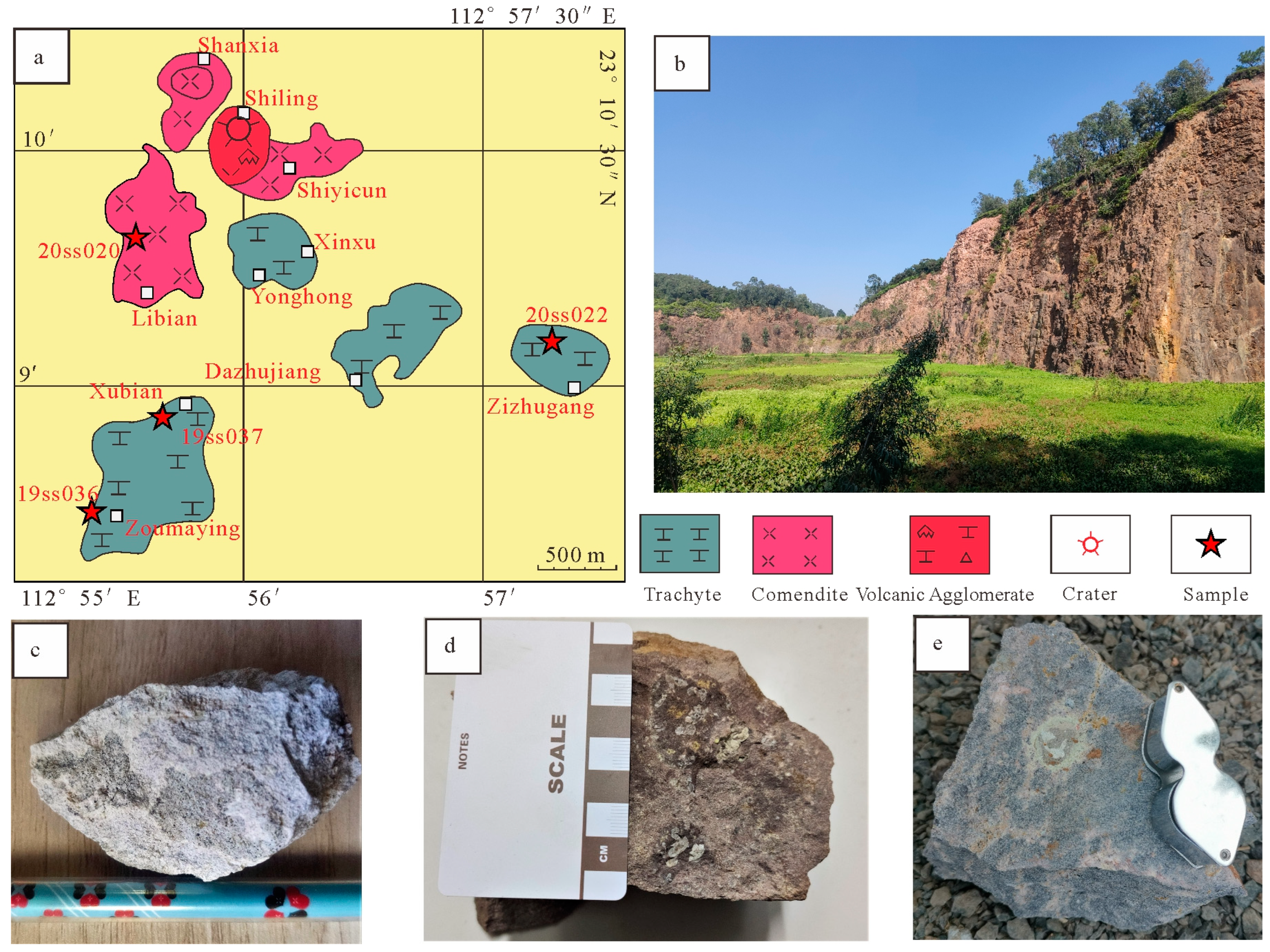
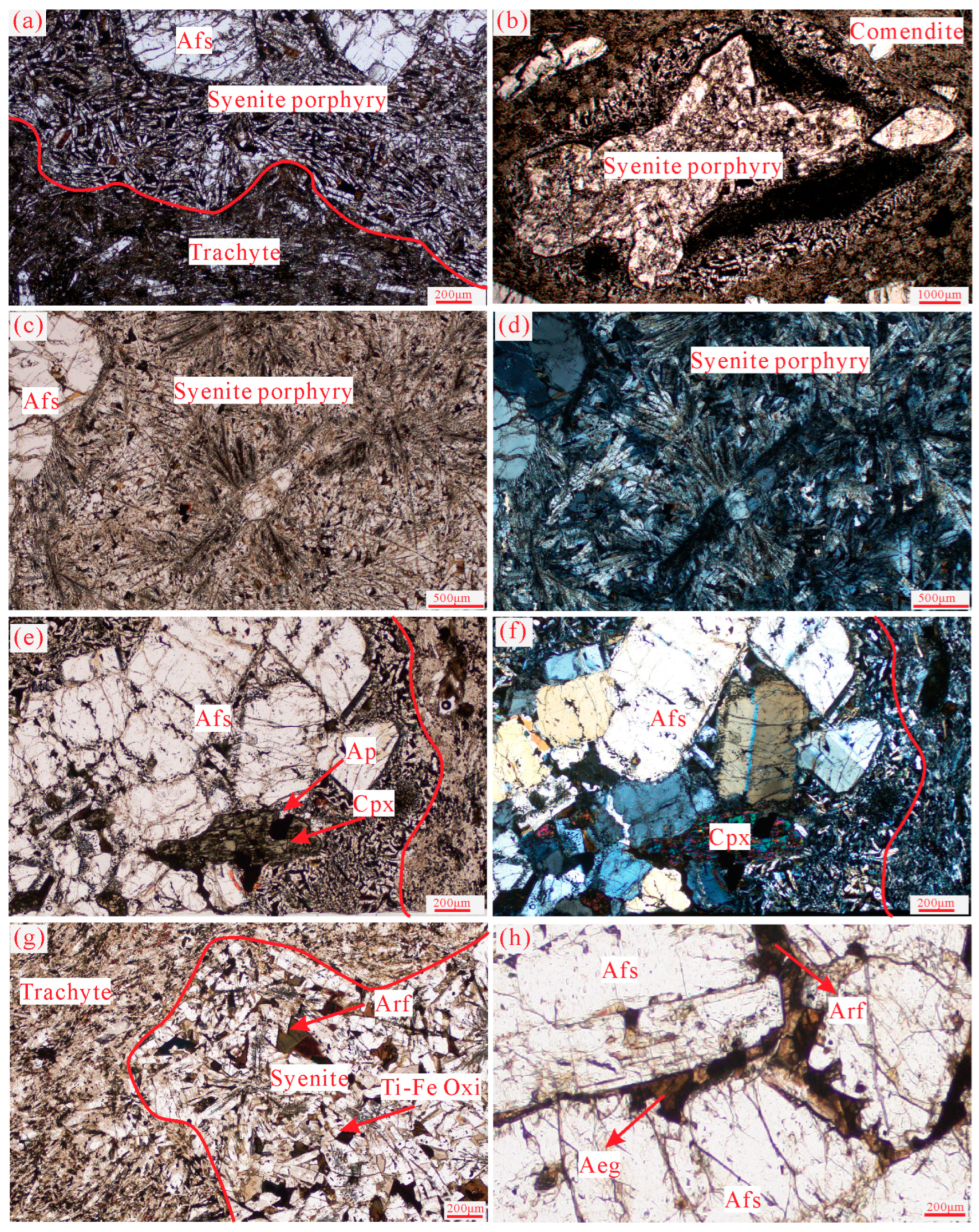
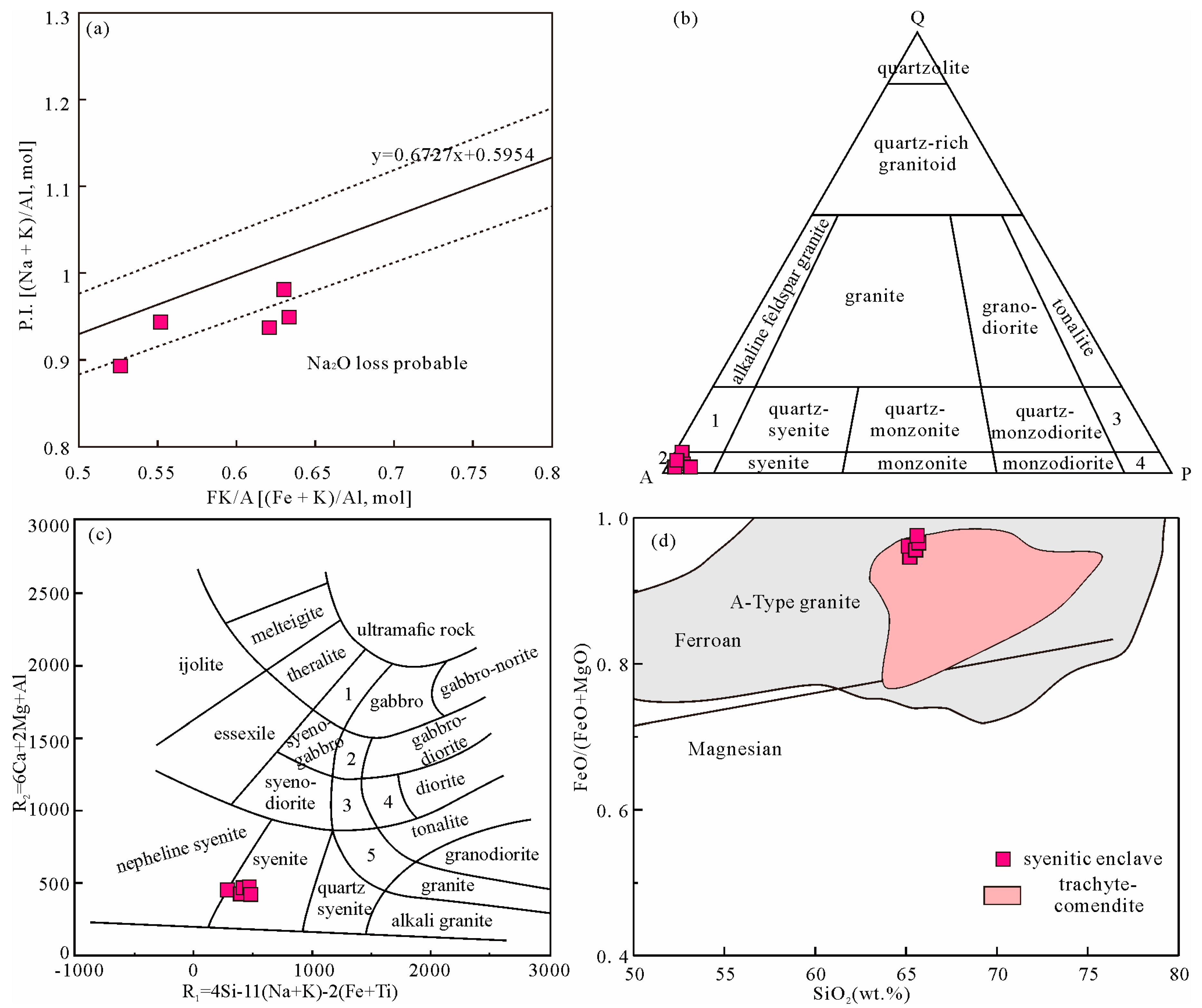
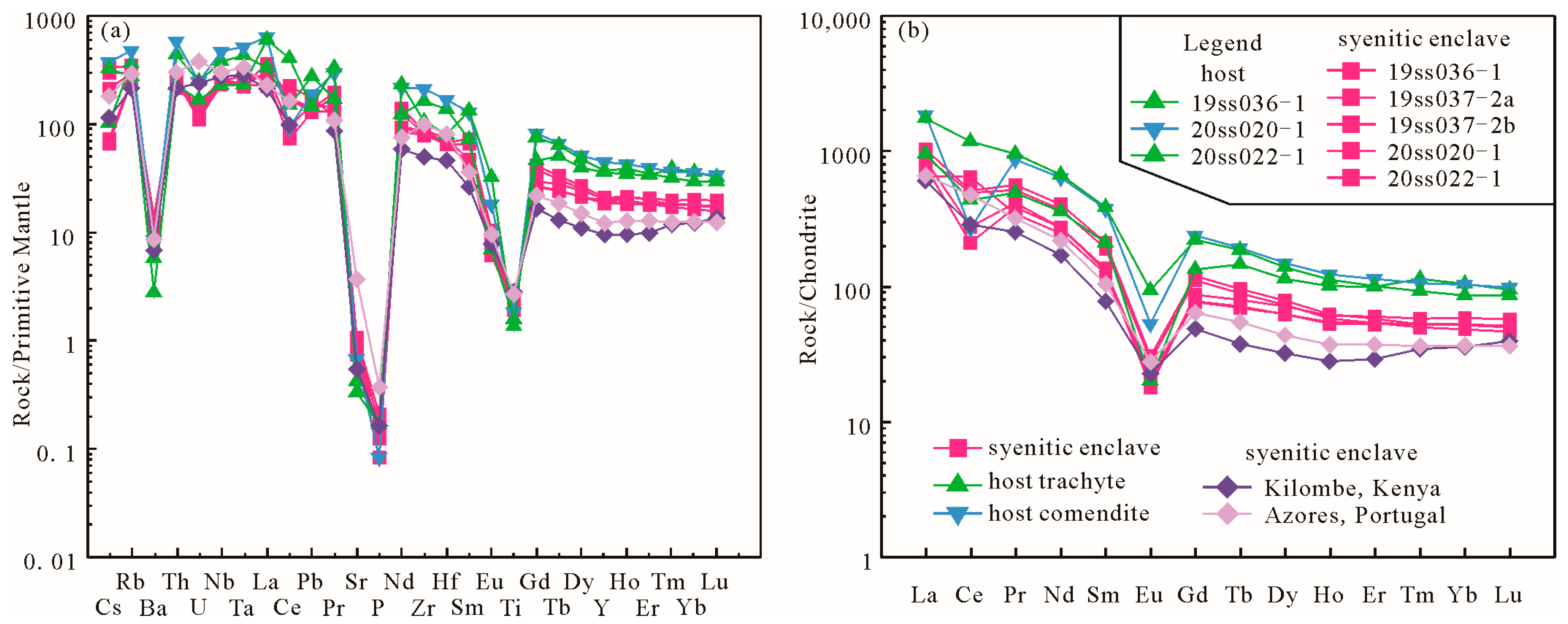
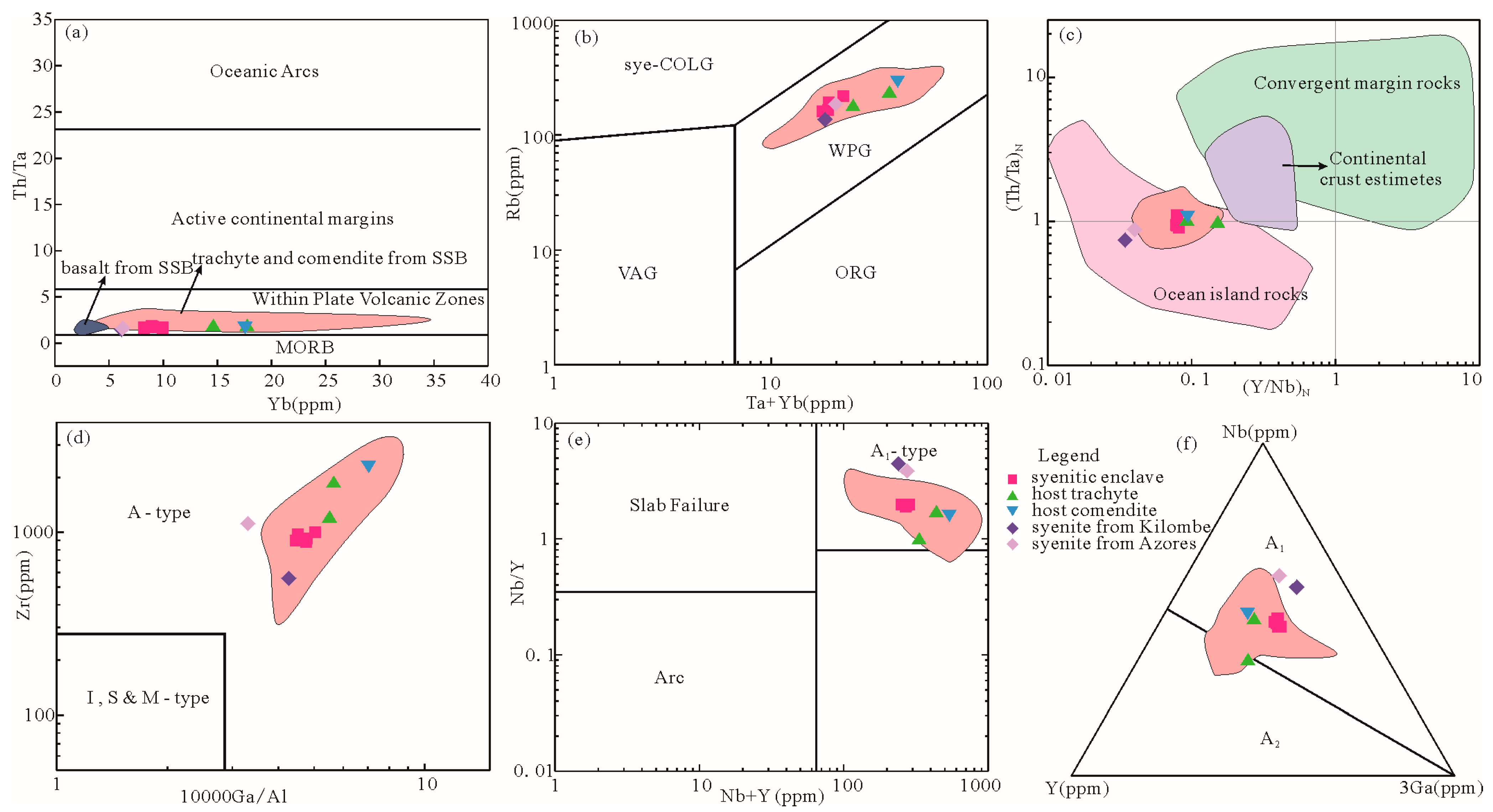
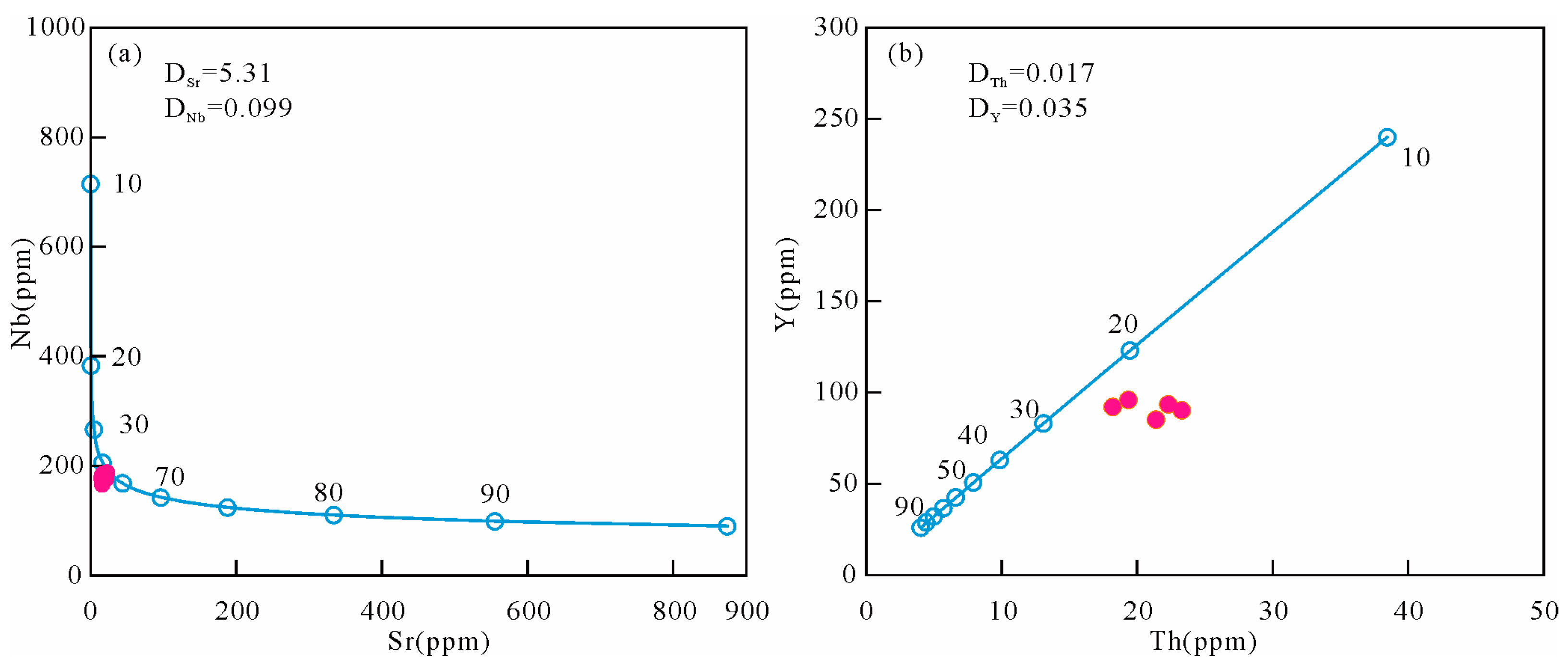
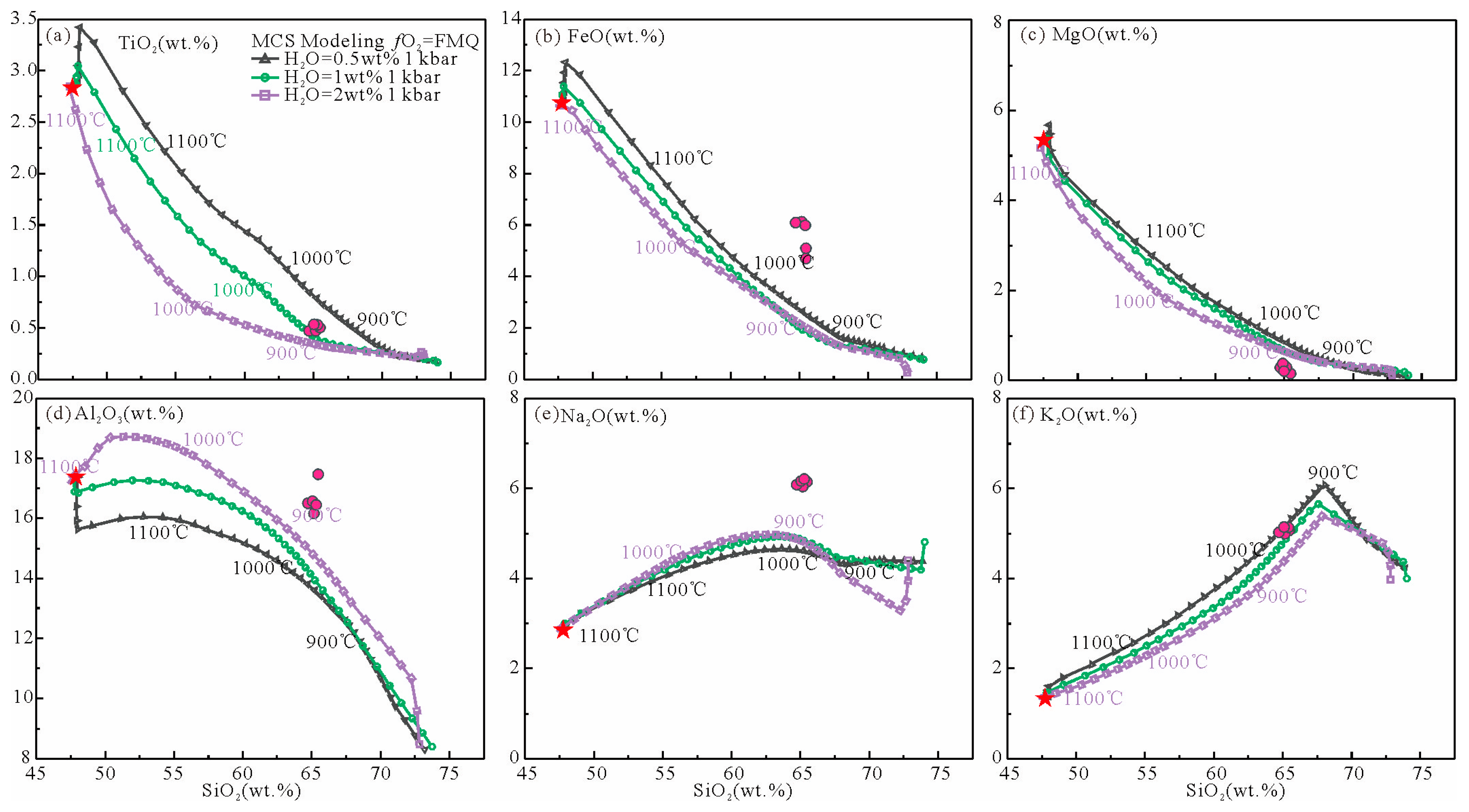
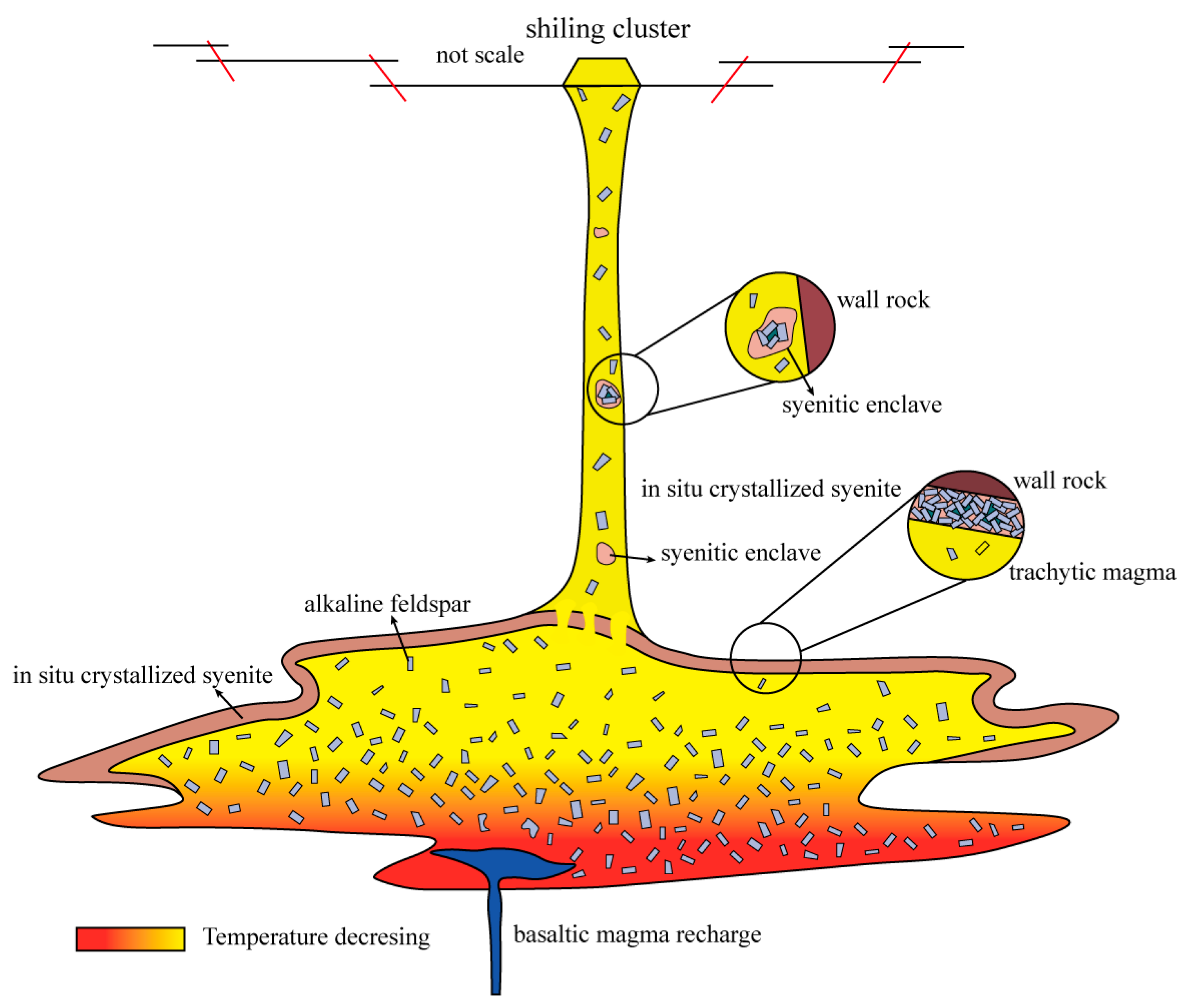
| Sample | 19ss036-1 | 19ss037-2a | 19ss037-2b | 20ss020-1 | 20ss022-1 | 19ss036-1 | 20ss020-1 | 20ss022-1 | Kilombe, Kenya | Azores, Portugal |
|---|---|---|---|---|---|---|---|---|---|---|
| Lat.(N) | 23°8′43″ | 23°8′47″ | 23°8′47″ | 23°9′45″ | 23°9′10″ | 23°8′43″ | 23°9′45″ | 23°9′10″ | ||
| Lon.(E) | 112°55′22″ | 112°55′47″ | 112°55′47″ | 112°55′41″ | 112°57′15″ | 112°55′22″ | 112°55′41″ | 112°57′15″ | ||
| rock type | syenite | syenite | syenite | syenite | syenite | trachyte | comendite | trachyte | syenite, n = 20 | syenite, n = 17 |
| group | enclave | enclave | enclave | enclave | enclave | host | host | host | enclave | enclave |
| SiO2 | 63.84 | 63.58 | 63.19 | 63.77 | 63.26 | 64.51 | 71.74 | 65.47 | 62.10 | 62.77 |
| TiO2 | 0.49 | 0.46 | 0.47 | 0.44 | 0.51 | 0.36 | 0.42 | 0.31 | 0.64 | 0.62 |
| Al2O3 | 17.03 | 15.77 | 16.11 | 16.56 | 16.10 | 15.66 | 12.51 | 15.55 | 15.72 | 16.89 |
| FeOt | 5.09 | 6.64 | 6.60 | 5.21 | 6.46 | 4.58 | 3.81 | 4.47 | 6.12 | 3.99 |
| MnO | 0.06 | 0.12 | 0.12 | 0.08 | 0.09 | 0.05 | 0.01 | 0.09 | 0.24 | 0.22 |
| MgO | 0.14 | 0.28 | 0.27 | 0.17 | 0.32 | 0.10 | 0.21 | 0.09 | 0.20 | 0.57 |
| CaO | 0.86 | 0.69 | 0.73 | 0.62 | 0.77 | 0.17 | 0.11 | 0.52 | 0.59 | 1.10 |
| Na2O | 5.99 | 5.89 | 5.94 | 6.19 | 6.22 | 5.44 | 3.66 | 6.68 | 6.99 | 7.09 |
| Na2O* | 7.06 | 7.13 | 7.23 | 6.92 | 7.15 | |||||
| K2O | 4.94 | 4.87 | 4.91 | 5.02 | 5.13 | 5.37 | 5.16 | 5.41 | 5.32 | 5.29 |
| P2O5 | 0.05 | 0.02 | 0.03 | 0.03 | 0.04 | 0.04 | 0.02 | 0.04 | 0.04 | 0.09 |
| LOI | 1.42 | 1.34 | 1.53 | 1.71 | 1.03 | 2.74 | 1.44 | 0.44 | 1.14 | 0.61 |
| Total | 99.91 | 99.66 | 99.90 | 99.80 | 99.93 | 99.02 | 99.09 | 99.07 | 99.11 | 99.23 |
| P.I. | 1.00 | 1.08 | 1.07 | 0.94 | 0.98 |
| Model | 14ss012-1 | 19ss036-1 | Cpx | Ol | Pl | Ap | Ilm | Mag | Odiff | Cdiff | RES |
|---|---|---|---|---|---|---|---|---|---|---|---|
| SiO2 | 47.41 | 64.12 | 48.56 | 38.25 | 51.39 | 0.21 | 0.28 | 0.27 | 16.72 | 16.50 | 0.22 |
| TiO2 | 2.79 | 0.49 | 1.4 | 0 | 0.13 | 0.09 | 51.89 | 26.65 | −2.30 | −2.42 | 0.12 |
| Al2O3 | 17.07 | 17.11 | 6.87 | 0.03 | 30.32 | 0.02 | 0.11 | 0.94 | 0.04 | 0.00 | 0.03 |
| FeOt | 10.00 | 5.11 | 7.22 | 22.86 | 0.61 | 0.8 | 45.25 | 70.58 | −4.89 | −5.01 | 0.11 |
| MnO | 0.15 | 0.06 | 0.13 | 0.35 | 0.01 | 0.1 | 0.74 | 1.45 | −0.09 | −0.11 | 0.02 |
| MgO | 7.31 | 0.14 | 14.78 | 38.15 | 0.08 | 0.36 | 1.51 | 0.05 | −7.17 | −7.18 | 0.01 |
| CaO | 8.76 | 0.86 | 20.44 | 0.24 | 12.75 | 52.24 | 0.14 | 0.03 | −7.90 | −7.87 | −0.03 |
| Na2O | 3.50 | 7.09 | 0.58 | 0.06 | 4.04 | 0.09 | 0.03 | 0.03 | 3.59 | 3.62 | −0.03 |
| K2O | 2.26 | 4.96 | 0.02 | 0.05 | 0.65 | 0.03 | 0.06 | 0 | 2.70 | 3.43 | −0.73 |
| P2O5 | 0.74 | 0.05 | 0 | 0 | 0.03 | 46.07 | 0 | 0 | −0.69 | −0.97 | 0.28 |
| Total | 100.00 | 100.00 | 100 | 100 | 100 | 100 | 100 | 100 | |||
| SSR | 0.59 | ||||||||||
| Wt% | 11.44 | 14.46 | 39.30 | 2.14 | 2.57 | 4.53 | 74.45 | ||||
| Nb | 89.7 | 188 | 188 | 302 | 114 | ||||||
| ZrS | 150 | 972 | 972 | 539 | −433 | ||||||
| Sr | 874 | 22.8 | 22.8 | 3 | −19.8 | ||||||
| Rb | 45.8 | 165 | 165 | 164 | −1 | ||||||
| Y | 26.1 | 96 | 96 | 96 | 0 | ||||||
| Ni | 90 | 0.5 | 0.5 | 0 | −0.5 | ||||||
| Th | 3.8 | 19.4 | 19.4 | 14 | −5.4 |
Disclaimer/Publisher’s Note: The statements, opinions and data contained in all publications are solely those of the individual author(s) and contributor(s) and not of MDPI and/or the editor(s). MDPI and/or the editor(s) disclaim responsibility for any injury to people or property resulting from any ideas, methods, instructions or products referred to in the content. |
© 2023 by the authors. Licensee MDPI, Basel, Switzerland. This article is an open access article distributed under the terms and conditions of the Creative Commons Attribution (CC BY) license (https://creativecommons.org/licenses/by/4.0/).
Share and Cite
Chen, P.; Qian, B.; Zhou, Z.; Fang, N. Cogenetic Origin of Magmatic Enclaves in Peralkaline Felsic Volcanic Rocks from the Sanshui Basin, South China. Minerals 2023, 13, 590. https://doi.org/10.3390/min13050590
Chen P, Qian B, Zhou Z, Fang N. Cogenetic Origin of Magmatic Enclaves in Peralkaline Felsic Volcanic Rocks from the Sanshui Basin, South China. Minerals. 2023; 13(5):590. https://doi.org/10.3390/min13050590
Chicago/Turabian StyleChen, Peijia, Bo Qian, Zhiwei Zhou, and Nianqiao Fang. 2023. "Cogenetic Origin of Magmatic Enclaves in Peralkaline Felsic Volcanic Rocks from the Sanshui Basin, South China" Minerals 13, no. 5: 590. https://doi.org/10.3390/min13050590




